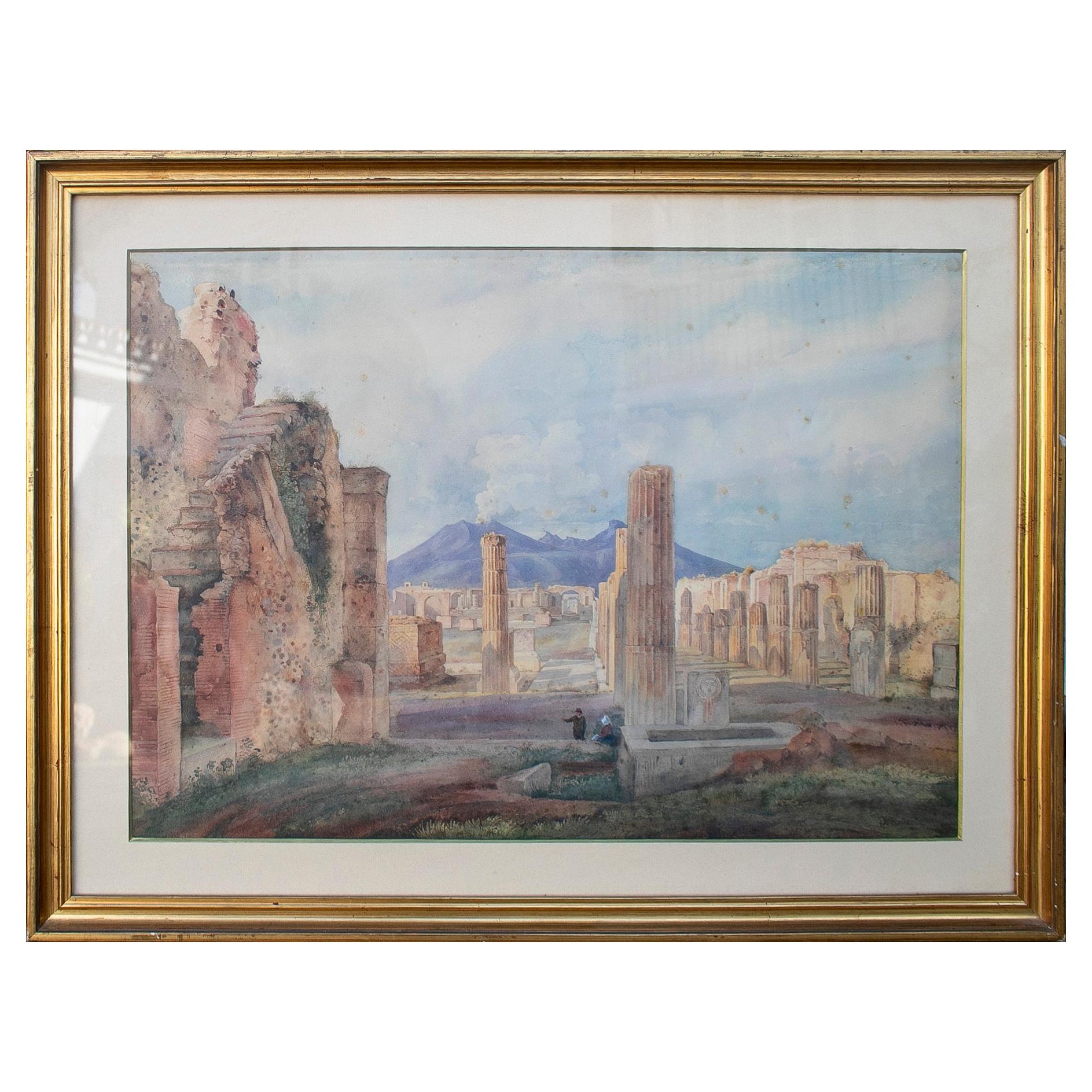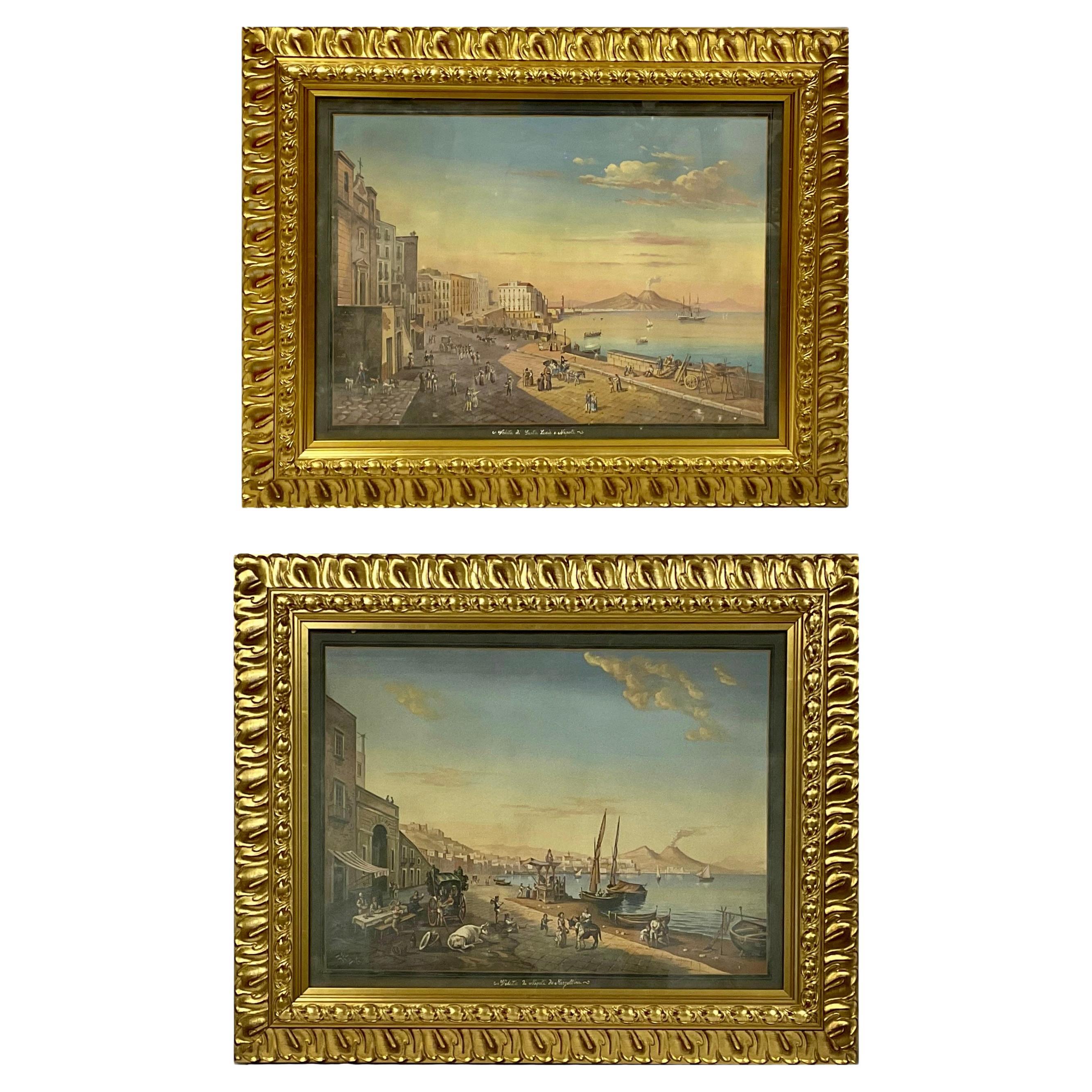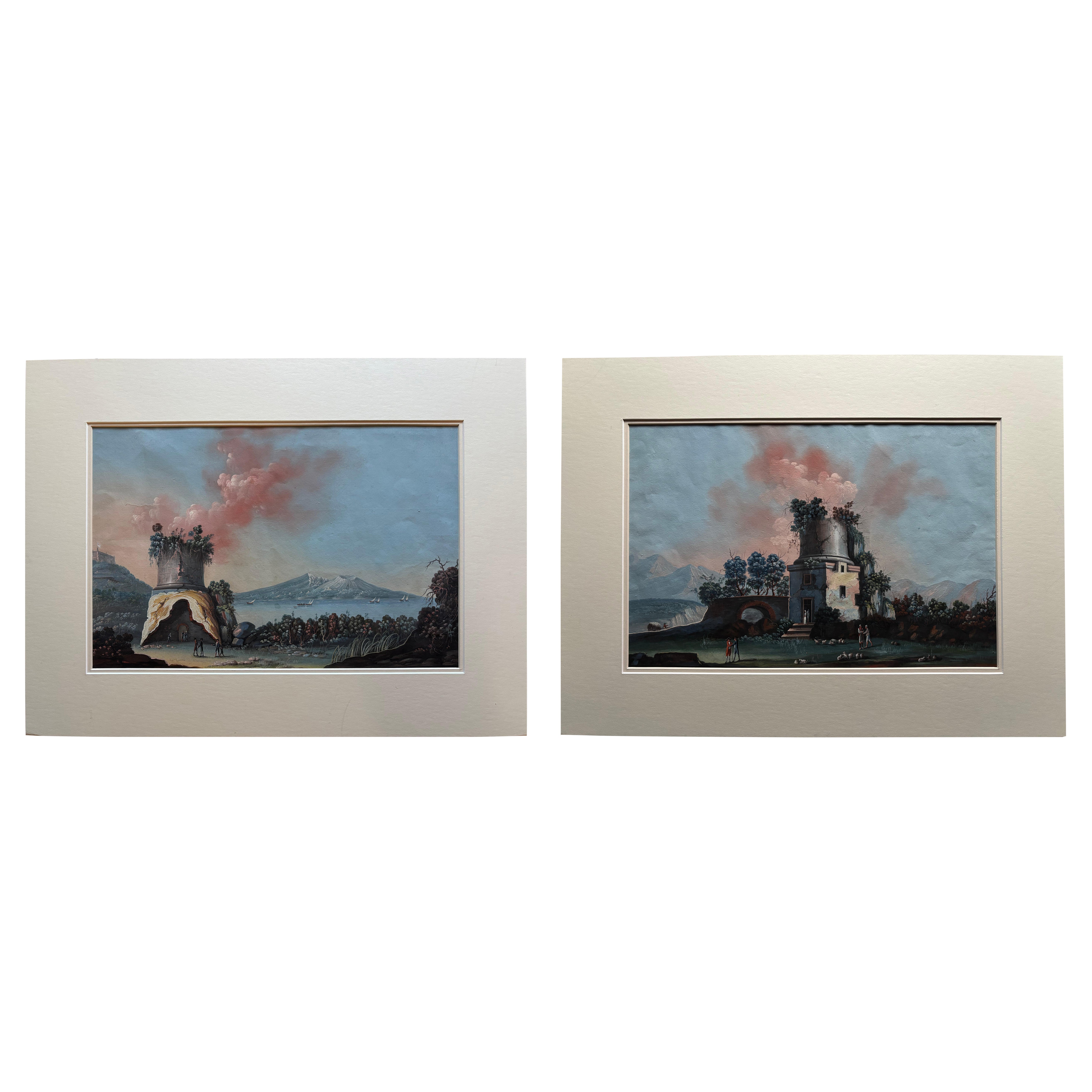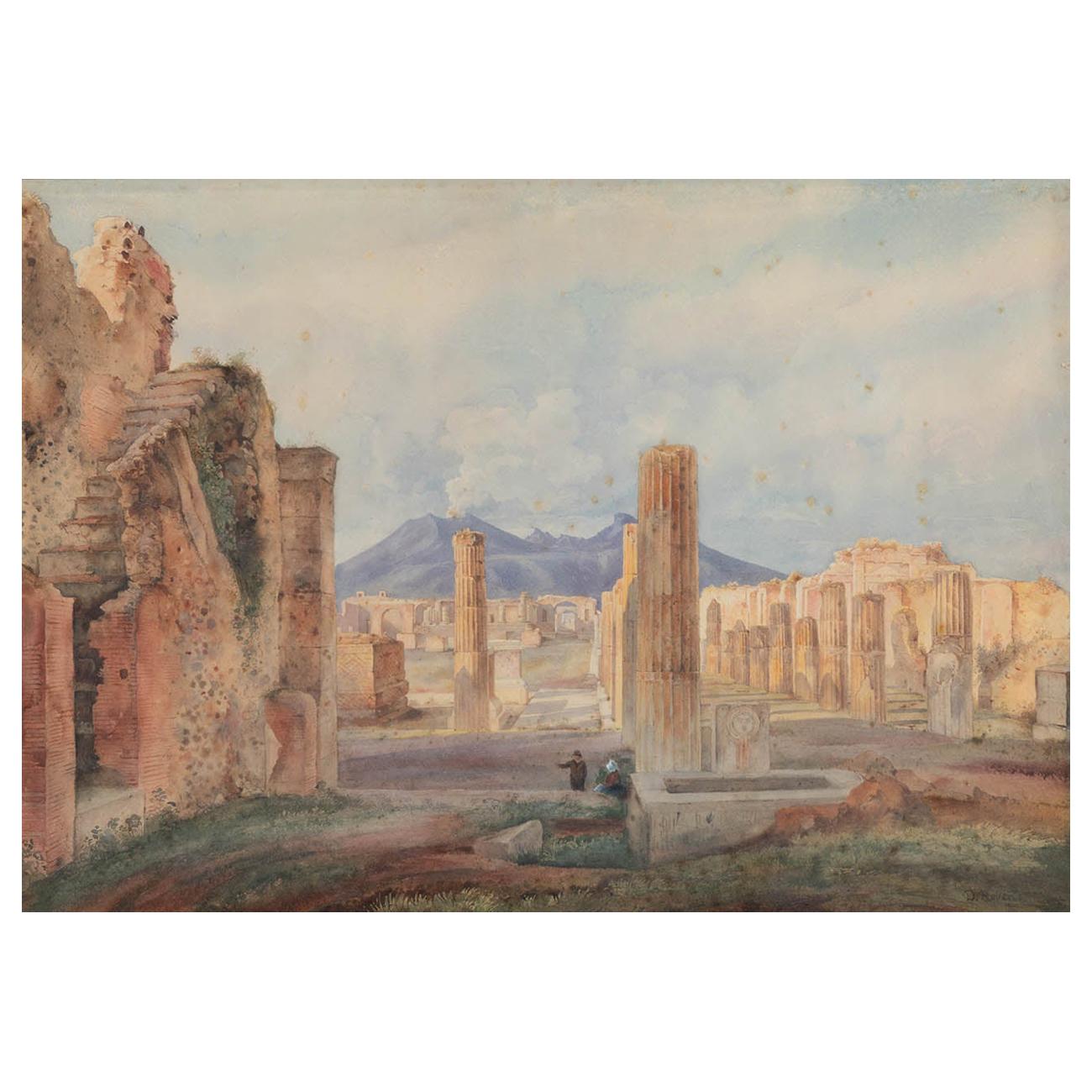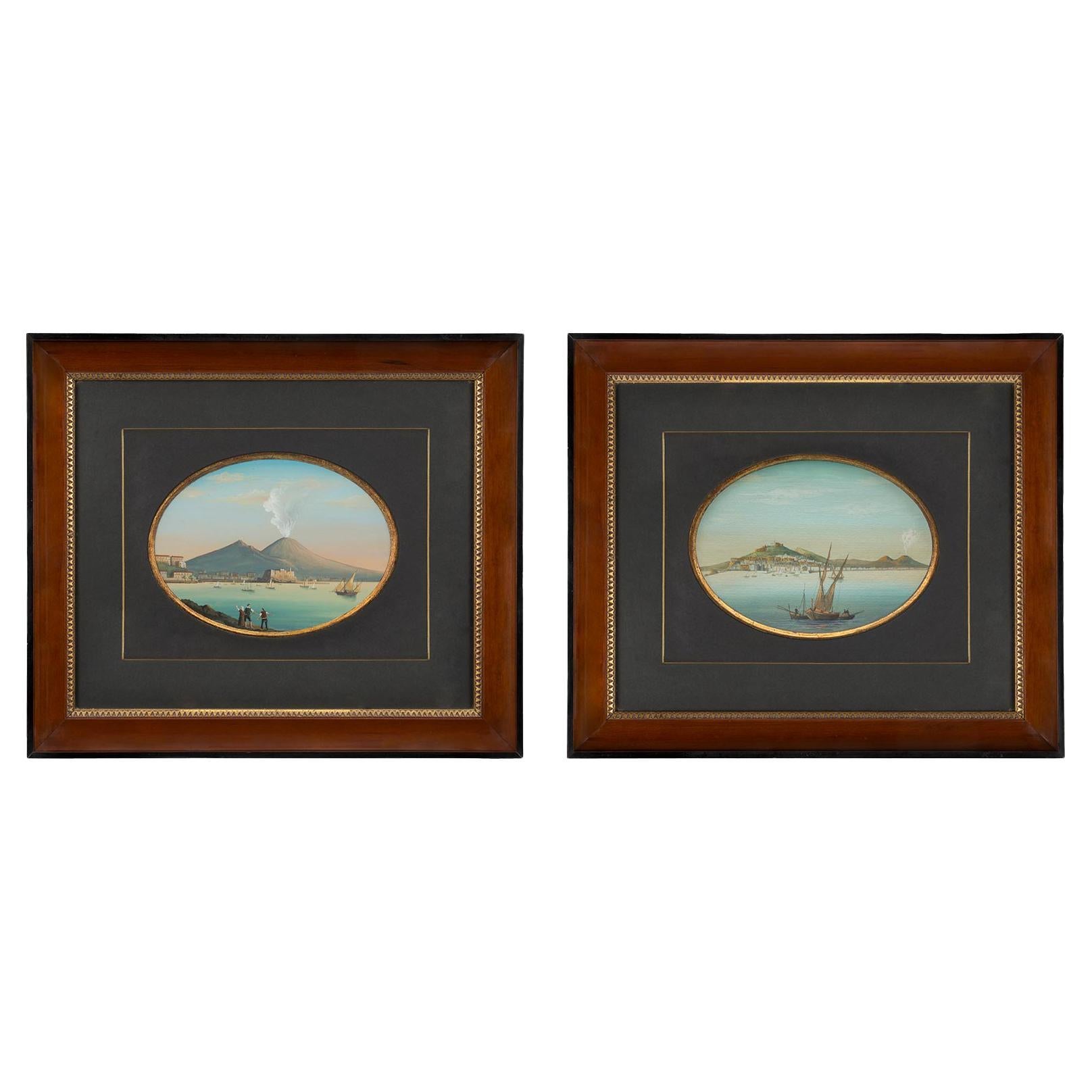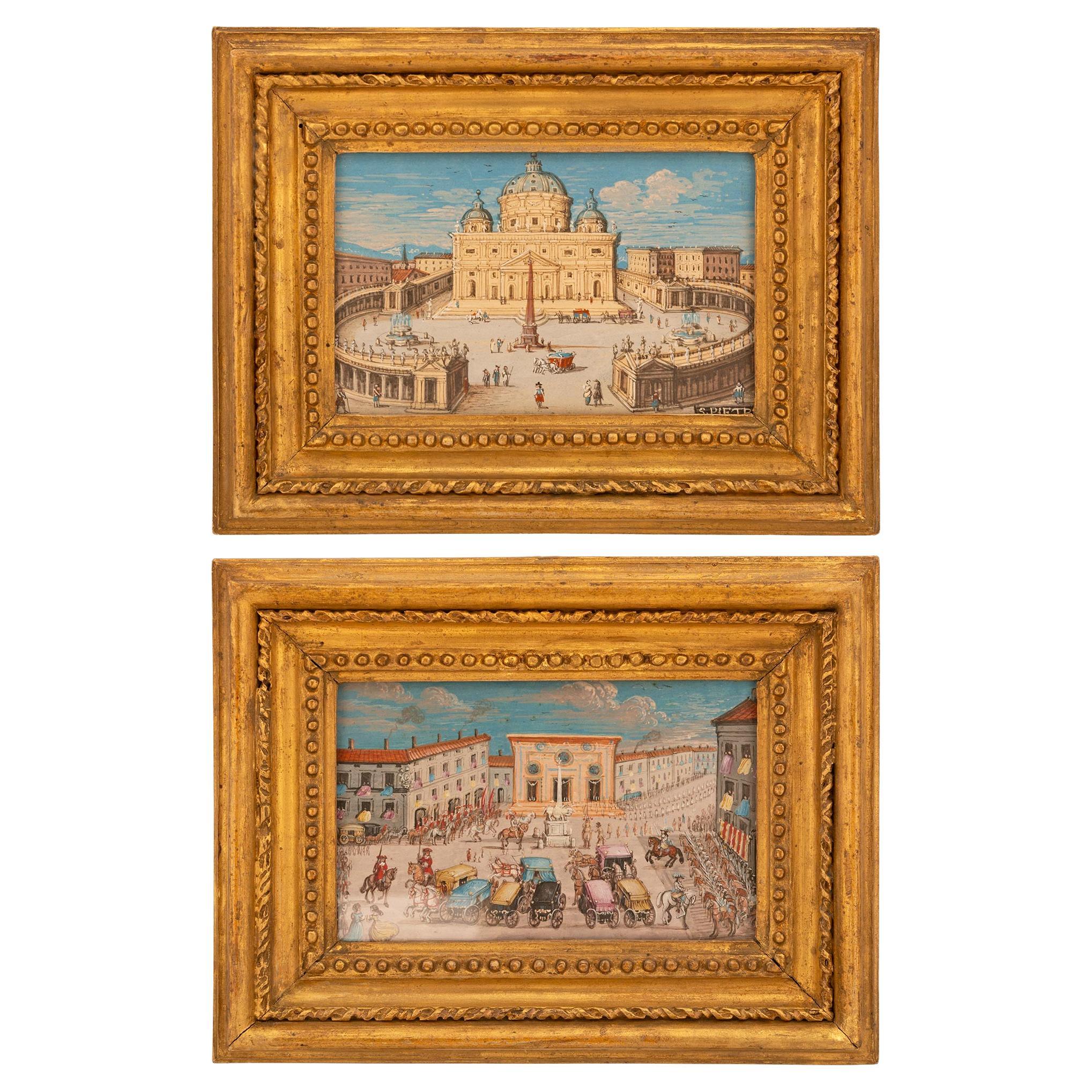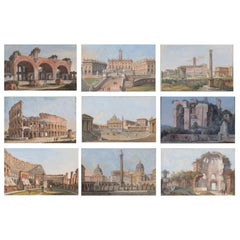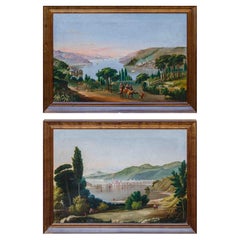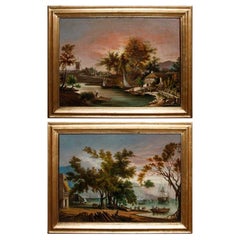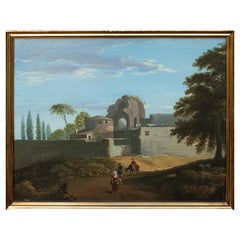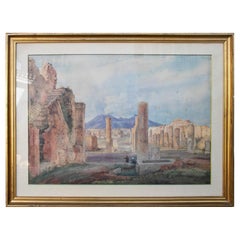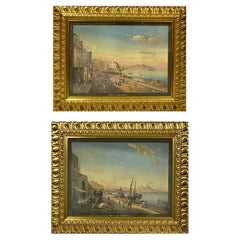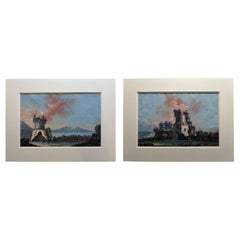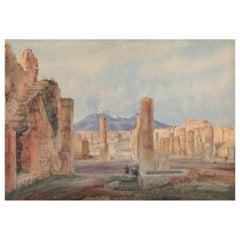Items Similar to 19th Century Views of Pompeii Paintings Tempera on Paper by Fergola
Want more images or videos?
Request additional images or videos from the seller
1 of 9
19th Century Views of Pompeii Paintings Tempera on Paper by Fergola
$5,368.10per set
£3,968.71per set
€4,500per set
CA$7,383.74per set
A$8,207.49per set
CHF 4,302.19per set
MX$100,233.29per set
NOK 53,710.35per set
SEK 50,531.42per set
DKK 34,258.43per set
About the Item
Francesco Fergola (Naples, 1801 - there, 1875)
Pair of Views of Pompeii
Tempera on paper, 33 x 48 cm
Frame 49 x 64 cm
The two views in question are signed by Francesco Fergola, a painter, known for his work as a landscape painter, born in Naples in 1801, since, in the act of death in 1875, he is said to be seventy-four. Son of the painter Luigi and brother of Salvatore, he is not to be confused with his nephew of the same name, also a painter, and his brother, also with the same name, an internationally renowned engineer and geographer. His approach, original and particular, less influenced by the Posillipo school, compared to his brother appears more linked to the Hackertian way of his father.
Endowed with a documentary precision in the shooting of the places derived from the so-called "bird's eye view" by PJ Hackert, the first certain information on his artistic activity are linked to the Bourbon exhibitions starting from before 1826 where he appears as part of the " Royal Institute of Fine Arts "and exhibited two paintings, winning the third class silver medal. In 1830 he presented a tempera, View of Naples, and was awarded the second class silver medal; the painting can perhaps be identified with a tempera on paper, View of Naples from Capodichino (Naples, royal palace), signed and dated 1830. Francesco was also present at the Bourbon exhibition of 1835 with an Eruption of Vesuvius. The two subjects depicted here are of great charm and interest, the Forum of Pompeii and the Via dei Sepolcri, also in Pompeii. The forum represented the main square of the city of which it was the political, economic and religious fulcrum. The Roman forum of Pompeii dates back to the 2nd century BC but great works were carried out in the Augustan age. The choice of representing the forum with the view of Vesuvius in the center of the composition to dominate the city is very fascinating, thus capturing the remains of the great temple of Jupiter Capitoline, the main building of worship in the city, located on the north side of the ancient piazza, erected as early as 250 BC This view allows you to imagine how much wonder the grandeur of the forum and the monumentality of the temple, dominated by Vesuvius, must have aroused, all enriched by the charm of the ruins. Some visitors, painted with attention to detail and clothing, they enliven the composition, transferring the past into the present, depicting how much the ancient already struck contemporaries. In the other painting we find the Via dei Sepolcri depicted; as a Roman custom, the road leading out of the city was used as a funerary space, flanked by sepulchral monuments. The street was beautifully immortalized by the words of Alexandre Dumas taken from Corricolo "a road that offers at its extremity., Like a great arch through which one sees nothing but the sky, that door by which one went from the city of the dead to the city ??of the living; that one surrounds all this with silence, solitude, meditation, and one will have an idea, still very incomplete, of the marvelous aspect that the suburb of Pompeii presents ". depicting how the ancient already struck contemporaries. In the other painting we find the Via dei Sepolcri depicted; as a Roman custom, the road leading out of the city was used as a funerary space, flanked by sepulchral monuments. The street was beautifully immortalized by the words of Alexandre Dumas taken from Corricolo "a road that offers at its extremity., Like a great arch through which one sees nothing but the sky, that door by which one went from the city of the dead to the city ??of the living; that one surrounds all this with silence, solitude, meditation, and one will have an idea, still very incomplete, of the marvelous aspect that the suburb of Pompeii presents ". depicting how the ancient already struck contemporaries. In the other painting we find the Via dei Sepolcri depicted; as a Roman custom, the road leading out of the city was used as a funerary space, flanked by sepulchral monuments. The street was beautifully immortalized by the words of Alexandre Dumas taken from Corricolo "a road that offers at its extremity., Like a great arch through which one sees nothing but the sky, that door by which one went from the city of the dead to the city ??of the living; that one surrounds all this with silence, solitude, meditation, and one will have an idea, still very incomplete, of the marvelous aspect that the suburb of Pompeii presents ". another painting depicts the Via dei Sepolcri; as a Roman custom, the road leading out of the city was used as a funerary space, flanked by sepulchral monuments. The street was beautifully immortalized by the words of Alexandre Dumas taken from Corricolo "a road that offers at its extremity., Like a great arch through which one sees nothing but the sky, that door by which one went from the city of the dead to the city ??of the living; that one surrounds all this with silence, solitude, meditation, and one will have an idea, still very incomplete, of the marvelous aspect that the suburb of Pompeii presents ". another painting depicts the Via dei Sepolcri; as a Roman custom, the road leading out of the city was used as a funerary space, flanked by sepulchral monuments. The street was beautifully immortalized by the words of Alexandre Dumas taken from Corricolo "a road that offers at its extremity., Like a great arch through which one sees nothing but the sky, that door by which one went from the city of the dead to the city ??of the living; that one surrounds all this with silence, solitude, meditation, and one will have an idea, still very incomplete, of the marvelous aspect that the suburb of Pompeii presents ". The street was beautifully immortalized by the words of Alexandre Dumas taken from Corricolo "a road that offers at its extremity., Like a great arch through which one sees nothing but the sky, that door by which one went from the city of the dead to the city ??of the living; that one surrounds all this with silence, solitude, meditation, and one will have an idea, still very incomplete, of the marvelous aspect that the suburb of Pompeii presents ". The street was beautifully immortalized by the words of Alexandre Dumas taken from Corricolo "a road that offers at its extremity., Like a great arch through which one sees nothing but the sky, that door by which one went from the city of the dead to the city ??of the living; that one surrounds all this with silence, solitude, meditation, and one will have an idea, still very incomplete, of the marvelous aspect that the suburb of Pompeii presents ".
- Dimensions:Height: 19.3 in (49 cm)Width: 25.2 in (64 cm)Depth: 1.58 in (4 cm)
- Sold As:Set of 2
- Materials and Techniques:
- Place of Origin:
- Period:
- Date of Manufacture:19th Century
- Condition:Wear consistent with age and use.
- Seller Location:Milan, IT
- Reference Number:1stDibs: LU5918226732962

About the Seller
5.0
Vetted Professional Seller
Every seller passes strict standards for authenticity and reliability
Established in 2000
1stDibs seller since 2021
30 sales on 1stDibs
Typical response time: 1 to 2 days
- ShippingRetrieving quote...Shipping from: Milan, Italy
- Return Policy
Authenticity Guarantee
In the unlikely event there’s an issue with an item’s authenticity, contact us within 1 year for a full refund. DetailsMoney-Back Guarantee
If your item is not as described, is damaged in transit, or does not arrive, contact us within 7 days for a full refund. Details24-Hour Cancellation
You have a 24-hour grace period in which to reconsider your purchase, with no questions asked.Vetted Professional Sellers
Our world-class sellers must adhere to strict standards for service and quality, maintaining the integrity of our listings.Price-Match Guarantee
If you find that a seller listed the same item for a lower price elsewhere, we’ll match it.Trusted Global Delivery
Our best-in-class carrier network provides specialized shipping options worldwide, including custom delivery.More From This Seller
View All18th Century Nine Views of Rome Painting Tempera on Paper
Located in Milan, IT
XVIII century Views of Rome
(9) Tempera on paper, 9 x 14 cm; with frame 34 x 40 cm
During the seventeenth century the fashion of the Grand Tour spread among the aristocracy, a ...
Category
Antique 18th Century Italian Paintings
Materials
Paper
19th Century, Views of the Bosphorus
Located in Milan, IT
19th Century
Views of the Bosphorus
Oil on canvas, 75.5 x 105 cm
Framed, 89 x 118 cm
In the full nineteenth-century taste for travel and Orientalism, the two splendid views captu...
Category
Antique 19th Century Turkish Other Paintings
Materials
Canvas
19th century, pair of landscapes
Located in Milan, IT
19thC
Pair of Landscapes
(2) Oil on canvas, 44 x 58 cm
With frame 58 x 71 cm
Category
Antique 19th Century Italian Other Paintings
Materials
Canvas
$4,294 / set
17th-18th Century View of the Temple of Minerva Painting Oil on Canvas
Located in Milan, IT
Painter active in Rome in the 18th-19th century.
View of the temple of Minerva Medica
Oil on canvas, 65 x 78 cm - with frame 71.5 x 85 cm
The painting bears a traditional attribution to François Marius Granet (Aix-en-Provence, 1775 - 1849). The painter was a pupil of David but from 1802 to 1819 he lived in Rome, as evidenced by a series of paintings depicting views of the city and especially of the Roman countryside (Ponte San Rocco in Tivoli, 1810-20, MoMA, New York), and then return there between 1825 and 1830. In the Eternal City Granet devoted himself to landscape painting, inspired by the landscape painting of Gaspard Dughet and Van Lint...
Category
Antique Late 17th Century Italian Paintings
Materials
Canvas
19th Century Florence View Painting Pallmann Oil Paint
Located in Milan, IT
Peter Götz Pallmann (Berlin, 1908 - 1966)
Santa Trìnita bridge in Florence
Oil on canvas applied to wood, 35 x 40 cm
Frame 45.5 x 50.5 cm
Signe...
Category
Antique 19th Century German Paintings
Materials
Canvas
19th century, Eight views of Milan
Located in Milan, IT
19thC
Eight views of Milan
(8) tempera on paper
(6) 16,5x21,56 cm - (1) 21,5x16 cm – (1) 17,5x24 cm
In these eight views, fine watercolor prints enclosed in elegant period fram...
Category
Antique 19th Century Italian Other Paintings
Materials
Paper
$10,020 / item
You May Also Like
19th Century Pompeii Landscape Grand Tour Watercolour w/ Mount Vesuvius
Located in Marbella, ES
Antique 19th century Pompeii landscape Grand Tour watercolour with mount Vesuvious in the background.
It was customary for European noble to...
Category
Antique 19th Century Italian Paintings
Materials
Paper
Pair of Italian 19th Century Neapolitan Gouaches
Located in Bradenton, FL
An absolutely exquisite pair of Italian 19th century Neapolitan gouaches in 20th century giltwood frames. One depicts the volcano eruption of 1822 in Naples, the other is an affluent...
Category
Antique 19th Century Italian Grand Tour Paintings
Materials
Paint
$4,440 Sale Price / set
40% Off
Pair 18th or 19th Century Italian Grand Tour Gouaches Of Vesuvius, Bay of Naples
Located in Stamford, CT
Pair of 18th or 19th century Neapolitan gouaches of Virgil's Tomb, one with a view of Mount Vesuvius and the Bay of Naples. This is a wonderful high quality pair of a rare subject. A...
Category
Antique Late 18th Century Italian Grand Tour Paintings
Materials
Paper
19th Century English "The Forum" Grand Tour Pompeii Watercolor
Located in Marbella, ES
19th century English "The Forum" Grand Tour Pompeii watercolor on paper, with Mount Vesuvius in the background.
Dimensions with frame: 62 x 82 cm.
Category
Antique Mid-19th Century English Paintings
Materials
Paper
Pair of Italian 19th Century Gouaches Depicting Scenes of Naples, Italy
Located in West Palm Beach, FL
A wonderful pair of Italian 19th century gouaches depicting scenes of Naples, Italy. Each with exquisite and vibrant colors within ebony and mahogany frames with a gilt inner band. O...
Category
Antique 19th Century Italian Paintings
Materials
Wood
pair of Italian early 19th century Oil on Canvas paintings of Roman landmarks
Located in West Palm Beach, FL
A most charming and small scale pair of Italian early 19th century Oil on Canvas and Giltwood paintings of Roman landmarks. The two colorful and intricately detailed painting depict ...
Category
Antique 19th Century Italian Paintings
Materials
Canvas, Giltwood, Paint
More Ways To Browse
Pompeii Wall Painting
Steve Burgess
Szasz Paintings
Thomas Pulgini
Turner Airbrush
Used Furniture North Shore Ma
Victor Petre
Vintage Magnolia Mirror
Vintage Vanguard Lee Reynolds
Weinstein Gallery
Wyatt Earp
Xavier Wurth
A Rangel Hidalgo Painting
Adolf Menzel
Albert Namatjira
Albert Radoczy
Alessandro La Volpe
Alessandro Magnasco
